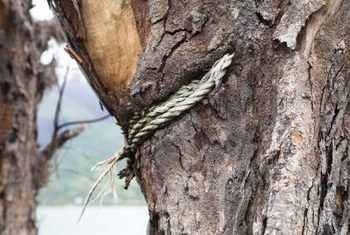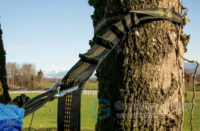 Rope covers, hammock straps and tree-climbing accessories help protect a tree from rope scars. Tying a rope around a tree for a hammock, boat or animal tether can scrape or cut the tree’s bark. Ropes used on branches for tree
Rope covers, hammock straps and tree-climbing accessories help protect a tree from rope scars. Tying a rope around a tree for a hammock, boat or animal tether can scrape or cut the tree’s bark. Ropes used on branches for tree
shaping, climbing or hanging swings cause friction and can wear through bark. The damage may expose the tree to diseases and pests. A rope tied around a tree trunk, however, may constrict the tree and kill it.
Pad the Rope
Lengths of rubber garden hose can be used to prevent rope from making direct contact with a tree. When placed between the rope and the tree, rubber hose reduces pressure on the bark and the risk of friction. The rubber hose pad method offers a quick solution if you need to support a weak trunk. Although this technique is often used on ropes stabilizing young trees, it still includes a risk of damage to tender bark.
Attach Rope to Straps
Using flat straps with grommets to support a tree produces less risk of damage to the bark than the rubber hose technique, according to Colorado State University Extension. Use two to three straps to stake one tree. Thread ropes through the grommets, and attach the ropes to stakes driven in the ground. The straps cover a wide surface along the trunk, spreading their pressure against the tree. Garden centers sell tree-staking straps. This method can be used to support a newly planted tree and to help straighten a tilting tree.
Employ Friction Guards
Arborist and recreational tree climbing equipment suppliers sell specialized equipment for protecting trees from ropes. Some friction savers are flat straps up to 6 feet long; they can be attached to climbing rope to prevent tree damage and increase climbing safety. Leather cambium savers follow the same principle as a rubber hose: The cambium guards keep rope off the bark. These devices, also called tree savers, are straightforward to use. Just feed rope through a friction guard, and place the guard over a branch or around the trunk, depending on how you want to use the rope. Tree topping, high pruning and other potentially hazardous tree work is best left to professionals.
Use Hammock Straps

Hammock straps made from flat webbing are designed to prevent bark abrasion. Different brands of hammock
straps are available, and the straps are adjustable to create a snug fit without harming a tree. Adjusting the straps as the tree grows prevents girdling, which will kill the tree; a tight rope prevents the tree from obtaining nutrients and water. Check sporting good suppliers for hammock hanging kits; a kit generally includes two straps for slinging a hammock between trees. These straps also work for suspending chairs and swings from trees.
